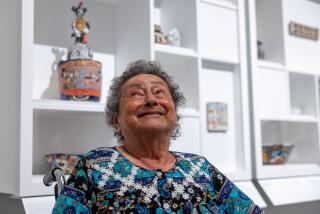Understated humor brings light to canvases shaded in darkness
- Share via
In the United States, we like to keep things simple. We tend to like comedies that make us laugh and tragedies that make us cry. Most of all, we like knowing the difference between the two. Nothing bugs North Americans in love with clarity and decisiveness more than the inability to know just what we’re supposed to be feeling.
South of the border, and in South America, things are both more and less complicated. More often than not, comedy and tragedy go hand in hand. Ambiguity is savored. The impulse to live one’s emotional life as if balancing one’s checkbook does not play as powerful a role in public consciousness.
Bruno Widmann’s recent paintings build on this tradition. At once stately and playful, serious and silly, the Uruguayan painter’s variously scaled acrylics on canvas at the Museum of Latin American Art in Long Beach combine abstraction and figuration in taut compositions that leave plenty of room for painterly flourishes and nuanced responses.
Widmann’s palette is dark. The 23 works in his first solo show in the United States are almost entirely comprised of a rich range of vast blacks, sumptuous grays and all manner of tans, taupes and ochres, many of which are interspersed with swatches of rusty umber, bands of weathered white and splotches of stop-sign red.
But the wintry tints and autumnal colors found across the vigorously worked surfaces of his paintings do not produce an atmosphere of funereal solemnity or stifling formality. On the contrary, Widmann’s shadowy palette is animated by an irrepressible sense of humor, all the more resilient for being understated.
At first, you merely intuit the light-handed levity that suffuses his abstract images. Most have the patched-together presence of secondhand quilts, their part-by-part compositions conveying a humble ethos of makeshift adaptation. Others look as if they depict worlds within worlds, modestly scaled microcosms set in boxy compartments within barren landscapes and the infinity of outer space. Still others embrace amusing diversions by including sections of checkerboards and other tabletop games.
The light that appears to shine from within many of Widmann’s paintings gives them a ghostly, photographic quality. Born in 1930, the painter never strives for the clinical precision of Photo-Realism nor the haunting melancholy of antique photographic processes. Instead, his use of dramatic lighting effects makes his art feel contemporary and accessible, neither stuffy and old-fashioned nor edgy and hip, but simply savvy to the mechanics of the media-saturated world in which we live.
His paintings are not fussed over. Widmann is not one to obsess over struggle for its own sake, nor to focus on the amount of labor that goes into each piece. This insures that his art remains fresh and buoyant, despite its somber palette.
All of these formal subtleties, which gently cue you in to Widmann’s sensibility, fade into the background when you notice the little stick figures that populate his paintings. What had seemed to be random puddles of paint and loose gestural doodles suddenly become people, whose postures, outfits and facial expressions are surprisingly vivid.
In “From the Dust Clouds I, II,” silhouetted figures climb, like mountaineers, along a vertical brushstroke. In “The Tunnel,” they walk in single file toward what is now the horizon. And in “Icons,” they huddle in a pair of small rooms, waiting silently.
As soon as you see one of Widmann’s schematic figures, others begin to appear, scampering through what are now abstract landscapes, like ants at a picnic. The longer you look, the more human activity you discern.
In the largest painting, a 12-foot-long diptych that resembles a cartoon version of a stone wall, a gaggle of folks dance, talk and lounge around, as if at a lively party. In “Where to? ... “ three men in tuxedos stare in different directions, as they do at art openings, at least in comic strips. In other images, Widmann flaunts his talents as a draftsman, transforming larger passages of paint into entire orchestras or military bands, complete with golden trombones, tubas and flutes, all dazzling in the sunshine.
Even with the figures, the ambiguity doesn’t diminish. The rows of soldiers in “United We Stand” look less like a celebration of military pageantry than an anonymous mob conscripted for some grim, unofficial duty. “Tomorrow, I Don’t Know” gives stark form to the uncertainty of modern life.
In all of Widmann’s paintings, all that is certain is that the world is bigger than any of us. His exhibition, titled “Two Seasons,” is a visual parable. With uncanny efficiency, it proposes that having a big-picture view of the world and having a big ego are inversely proportionate to one another.
The strand of Romanticism that lives on in his art is neither sappy in its sentimentality nor overblown in its heroics. On intimate terms with how absurd life can be, Widmann’s paintings are also utterly reasonable. They depict a world in which little events -- and little people -- are more important than anything in the headlines.
*
‘Bruno Widmann: Two Seasons/Dos Estaciones’
When: Tuesday-Friday, 11:30 a.m. to 7 p.m.; Saturday, 11 a.m. to 7 p.m.; Sunday, 11 a.m. to 6 p.m.
Where: Museum of Latin American Art, 628 Alamitos Drive, Long Beach
Ends: July 6
Price: $3-$5
Contact: (562) 437-1689
More to Read
The biggest entertainment stories
Get our big stories about Hollywood, film, television, music, arts, culture and more right in your inbox as soon as they publish.
You may occasionally receive promotional content from the Los Angeles Times.










